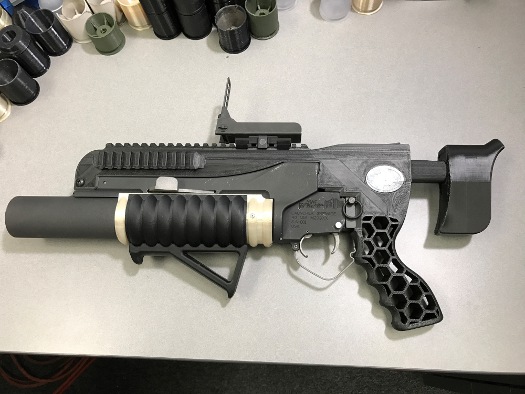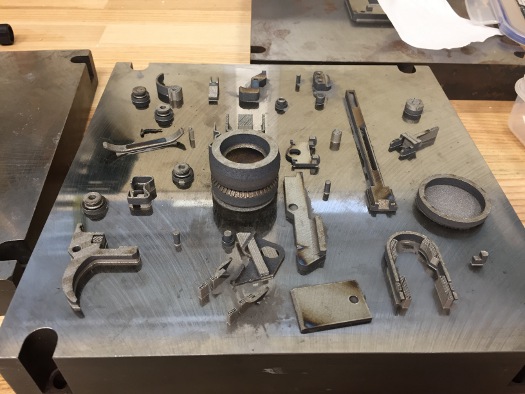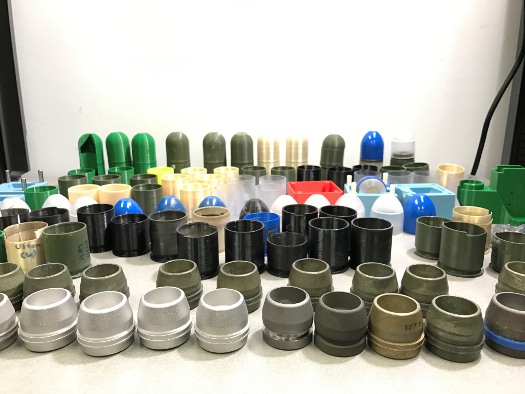 |
| March 14, 2017 | Volume 13 Issue 10 |
Designfax weekly eMagazine
Archives
Partners
Manufacturing Center
Product Spotlight
Modern Applications News
Metalworking Ideas For
Today's Job Shops
Tooling and Production
Strategies for large
metalworking plants
U.S. Army 3D prints working grenade launcher and ammo
What's better than a 3D-printed prototype grenade launcher? One that works -- with 3D-printed ammo -- of course.
An article published online March 1 on the U.S. Army Acquisition Support Center website outlines the efforts of researchers at the U.S. Army Armament Research, Development and Engineering Center (ARDEC) and industry partners to push the state of the art in 3D-printing prototype technology. Their goal: produce via various additive manufacturing technologies a working M203A1 40-mm grenade launcher and M781 munitions.
Did they succeed?
Yup -- with a bang.
What else would you expect from a prototype named RAMBO (Rapid Additively Manufactured Ballistics Ordnance)?

The 3D-printed M203 grenade launcher "RAMBO" system includes an NSRDEC-designed standalone kit with printed adjustable buttstock, mounts, grips, and other modifications. [U.S. Army photo by Sunny Burns, ARDEC]
The launcher and ammo, which were the results of six months of effort by the U.S. Army Research, Development and Engineering Command (RDECOM), the U.S. Army Manufacturing Technology (ManTech) Program, and America Makes (the national accelerator for additive manufacturing and 3D printing), were live-fire tested for the first time on Oct. 12, 2016, at the Armament Technology Facility at Picatinny Arsenal in New Jersey.
The article describing the whole process, authored by ARDEC engineers Seung kook "Sunny" Burns and James Zunino, details the trials, tribulations, and tradeoffs of developing the functional armament. It reveals that "every component in the M203A1 grenade launcher, except springs and fasteners, was produced using AM (additive manufacturing) techniques and processes." The launcher itself has 50 components total.
"The barrel and receiver were fabricated in aluminum using a direct metal laser sintering (DMLS) process. ... Other components, like the trigger and firing pin, were printed in 4340 alloy steel, which matches the material of the traditional production parts."
Foremost in the process was to concentrate on using a multitude of technologies to discover how far 3D printing technologies could be pushed to make better prototypes faster -- not how to produce finished weapons (even cheaper finished weapons) directly for the battlefield.
Like most 3D-printed parts, there was a lot of finish work involved. "The printed aluminum receiver and barrel required some machining and tumbling," the article states. "The receiver required more post-process machining to meet the tighter dimensional requirements." The barrel (70 hours to print, 5 hours of post-process machining) and receiver both underwent Type III hard-coat anodizing.
But overall, more than 90% of the components in the prototype grenade launcher were printed with AM in just 35 hours and on a single build plate.

On the M203 grenade launcher, all of the parts except for springs and fasteners were produced with 3D printing. [U.S. Army photo by Sunny Burns, ARDEC]
Two RDECOM research and development centers, the U.S. Army Edgewood Chemical and Biological Center (ECBC) and the U.S. Army Research Laboratory (ARL), worked on 3D printing the ammo.
"The M781 40-mm training round (was chosen) because it is simple and does not involve any [integrated] energetics," the article states. "Explosives, propellants, and pyrotechnics are still awaiting approval for use in 3D printing."
Selective laser sintering and other AM processes were used to print glass-filled nylon cartridge cases and windshields for the rounds. The .38-caliber cartridge case [propellant charge] was the only component of the M781 that was not printed. The case "was purchased and pressed into the additively manufactured cartridge case."
The M781 projectile body is currently made of zinc, a material that is not used in 3D printing right now. Four options were tested to produce this part, including using aluminum instead, steel with a urethane obturating ring, plastic printed directly onto the steel projectile body, and casting zinc projectile bodies using a lost-wax process that utilized a 3D wax printer to make the mold.

These M781 training-round components were also 3D printed. [U.S. Army photo by Sunny Burns, ARDEC]
On live-fire testing day, the grenade launcher was fired remotely. "The testing included 15 test shots with no signs of degradation. All the printed rounds were successfully fired, and the printed launcher performed as expected," the article states. "There was no wear from the barrel, all the systems held together, and the rounds met muzzle velocities within 5 percent of a production M781 fired from a production-grade grenade launcher. The variation in velocities were a result of the cartridge case cracking, and the issue was quickly rectified with a slight design change and additional 3D printing."
Read the full article, which will be published in the April/June 2017 issue of Army AL&T Magazine, here.
Source: U.S. Army Acquisition Support Center
Published March 2017
Rate this article
View our terms of use and privacy policy
